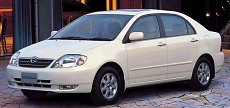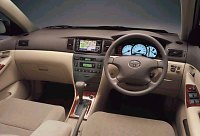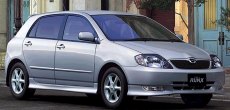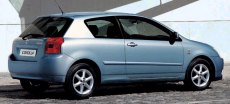 Corolla
never raised my curiosity. In car enthusiasts point of view, it always
lived under the shadow of arch-rival Honda Civic. Then, why were there
so many people buy the Corolla? what made it the no. 1 best seller in
history,
with 28 million people purchased 8 generations of Corolla since 1966?
From
the beginning, the Corolla’s winning formula has been reliability,
economical
and good after-sale service. This latest Corolla is more or less
so. Corolla
never raised my curiosity. In car enthusiasts point of view, it always
lived under the shadow of arch-rival Honda Civic. Then, why were there
so many people buy the Corolla? what made it the no. 1 best seller in
history,
with 28 million people purchased 8 generations of Corolla since 1966?
From
the beginning, the Corolla’s winning formula has been reliability,
economical
and good after-sale service. This latest Corolla is more or less
so.
First of all, let us go through the whole Corolla family. The 9th generation is simplified under cost reduction policy, leaving only 4-door sedan (simply Corolla), 5-door hatch (Runx or Allex, with just cosmetic differences between them), estate (Fielder) and mini-MPV (Spacio) surviving. In other words, derivatives such as Sprinter, Levin and Trueno have passed away silently. It’s a pity, because Levin / Trueno (your "Corolla coupe") was once an exciting pocket-rocket. Here we are going to talk about the 4-door sedan, which is not yet on sale overseas. Compare with the previous generation, it gets extra wheelbase which was desperately needed. Although 2600 mm is by no means class-leading, it is already 135 mm longer than before. In addition, the new Corolla adopts a MPV-profile (like Prius), with very high roof and cab-forward windscreen to boost interior space. That means it is very spacious, although not quite up to the record set by Civic 5-door. The negative side is a fat proportion that - accompany with the incompetence of Japanese designers - deliver a boring message. Here, Toyota should have referred to Audi A2 or Peugeot 307 to understand that MPV-profile is not necessarily boring.
The comfort-biased feel extend to the chassis. There’s nothing wrong with front struts and rear torsion beams, but springs and dampers are set soft, generating a lot of body roll. While it rides more supple and quieter than Lancer Cedia, it is quite far away from Civic’s level, let alone Ford Focus. Bouncing at high frequency bumps, floaty at high speed, this reflects the problem is not just "designed to be comfort" but the inadequate tuning. New electric-power steering is too light and lack of feel, especially at high speed. Brake pedal effort also favour housewives. Comparatively, engine is the strongest mechanical part of Corolla. Both 1.5-litre (110ps) and 1.8-litre (136ps) four-pot are smooth, quiet and torquey throughout a wide band, thanks to the infinitely variable VVT-i. The 4-speed automatic transmission is not quite so. Basically carried over from the previous generation, it is sometimes jerky. For domestic market there is no option of 5-speed manual, but the Runx and Allex hatchbacks can be powered by Celica’s 190 hp VVTL-i engine which mates with a superb 6-speed manual. Again, the Corolla disappoints car lovers. While Ford, Peugeot and Honda prove that a comfortable car can also be a great driver’s car, Toyota is still contenting with its old formula.
|
| The above report was last updated on 3 June 2001. All Rights Reserved. |
 In
terms of comfort and convenience, the new Corolla rates high. Although
rear passengers would have preferred Civic’s flat floor, the Corolla
has
plenty of head and shoulder room to match its arch-rival. Moreover, the
high-mounted seats are easy to access, though keen drivers might not
like
that. Seat cushion is thick and comfortable, if not laterally
supportive.
The cabin is trimmed and built with high-quality material and superb
fit
and finish, rather like a mini Lexus. Nevertheless, design is very
dull,
washing out any good impression we have already mentioned. Therefore
the
Corolla looks not a bit desirable no matter from outside or inside.
In
terms of comfort and convenience, the new Corolla rates high. Although
rear passengers would have preferred Civic’s flat floor, the Corolla
has
plenty of head and shoulder room to match its arch-rival. Moreover, the
high-mounted seats are easy to access, though keen drivers might not
like
that. Seat cushion is thick and comfortable, if not laterally
supportive.
The cabin is trimmed and built with high-quality material and superb
fit
and finish, rather like a mini Lexus. Nevertheless, design is very
dull,
washing out any good impression we have already mentioned. Therefore
the
Corolla looks not a bit desirable no matter from outside or inside.


 Fine
tuning to suspensions and steering are very important. Most cars in the
D-segment employ the same kind of suspensions (front struts, rear
torsion-beam
axle) and steering (rack-and-pinion). What separate a good driver’s car
from a poor one is usually the fine tuning of every components. The
Japanese
Corolla - as described above - was heavily criticized for its light
steering
and soft suspensions. Now thoroughly retuned by Toyota’s Germany
R&D
center, the European version of Corolla drives like another car.
Fine
tuning to suspensions and steering are very important. Most cars in the
D-segment employ the same kind of suspensions (front struts, rear
torsion-beam
axle) and steering (rack-and-pinion). What separate a good driver’s car
from a poor one is usually the fine tuning of every components. The
Japanese
Corolla - as described above - was heavily criticized for its light
steering
and soft suspensions. Now thoroughly retuned by Toyota’s Germany
R&D
center, the European version of Corolla drives like another car.
 Spacio
is derived directly from Corolla, that's why in overseas market it is
called
Corolla Verso. In Toyota's dictionary, Verso means versatility, or in
other
words, MPV.
Spacio
is derived directly from Corolla, that's why in overseas market it is
called
Corolla Verso. In Toyota's dictionary, Verso means versatility, or in
other
words, MPV.